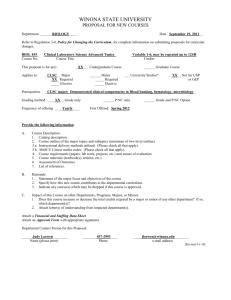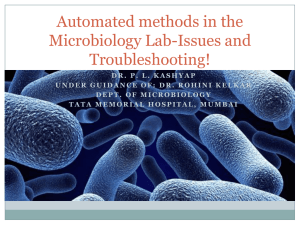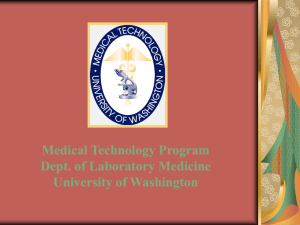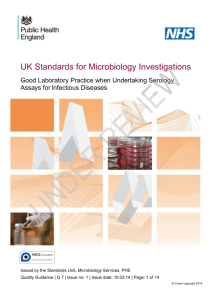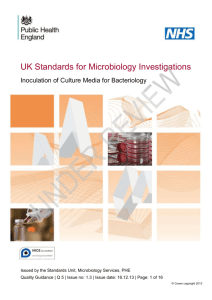laboratoryservicesinhospitalbyihmr-b
advertisement
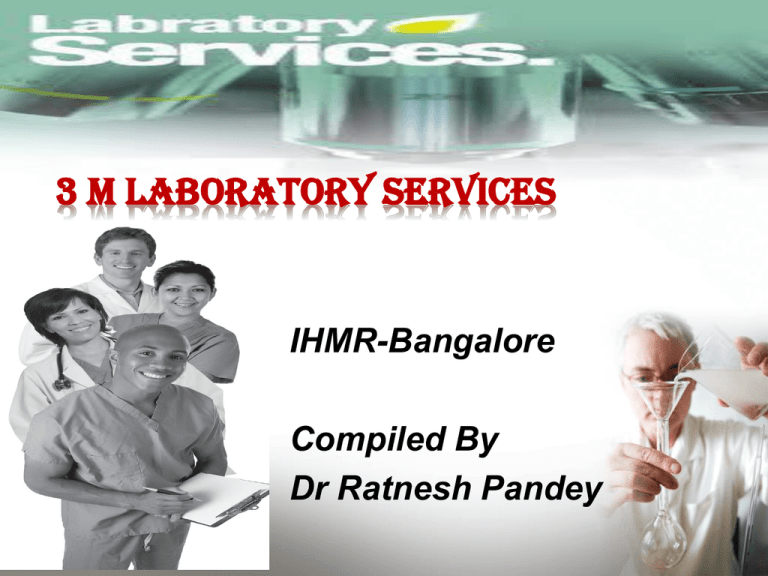
3 M LABORATORY SERVICES IHMR-Bangalore Compiled By Dr Ratnesh Pandey • • • • 3 M LABORATORY SERVICES MANAGING MONITORING & MASTERING Outline Introduction Defining Lab & Lab Services Types of Lab Lab Services Importance of Lab Services Lab Equipment Lab Information System Lab Services Lab Medicines Lab Safety Planning Staffing NABL Research & Training Policies Procedures Role of Administration Conclusion A medical laboratory is a place where tests are done on clinical specimens and samples in order to get information about the health of a patient as pertaining to the diagnosis, treatment, and prevention of disease Laboratory Services include testing of materials, tissues or fluids obtained from a patient or clinical studies to determine the cause and nature of disease Medical Laboratories Clinical Pathology Clinical Microbiology Clinical Biochemistry Haematology Bacteriology Biochemical analysis Histopathology Mycobacteriology Hormonal assays Cytology Virology Routine Pathology Mycology Parasitology Immunology Serology What are Laboratory Services all about? Laboratory Services play a critical role in the detection, diagnosis and treatment of disease. Samples are collected and examination and analysis of body fluids, tissue and cells are carried out. Main services are: To Perform diagnostic tests To Identify organisms, like E-coli bacteria To Count and classify blood cells to identify infection or disease To Operate complex diagnostic equipment To Perform immunological tests to check for antibodies To Type and cross-match blood samples for transfusions To Analyze DNA Services we provide.. • Microbiology • Parasitology • Virology • Haematology • Coagulation • Clinical Biochemistry • Toxicology • Immunohaematology/Blood bank • Urinalysis • Histopathology • Cytopathology • Electron microscopy • Genetics • Cytogenetics • Surgical pathology • Immunology/Serology Lab equipments and LIS Planning for equipments • Basic instruments and equipments should be made available • All vital equipment should be in duplicate or have an alternative arrangement • Selecting the best instrument for the laboratory is a very important part of equipment management Following element should be considered during management program in laboratory: 1) Selection and purchasing 2) Installation 3) Calibration and performance evaluation 4) Maintenance 5) Troubleshooting 6) Service and repair 7) Retiring and disposing of equipment Lab equipments Basic equipments for all types of routine investigations are: 1) Colorimeter/Photoelectric colorimeter: Its a device that measures the absorbance of particular wavelengths of light by a specific solution 2) Centrifuge: Is a piece of equipment, generally driven by an electric motor that puts an object in rotation around a fixed axis, causing denser substances to separate and by which lighter objects will tend to move on top 3) Water Bath: A device for regulating the temperature of anything subjected to heat, by surrounding the vessel containing it with another vessel containing water which can be kept at a desired temperature Continued…………………………. 4) Microscope- Mono Ocular/binocular: Is an instrument used to see objects that are too small for the naked eye 5) Hot air oven: Are electrical devices used in sterilization 6) Autoclave: Is a device used to sterilize equipment and supplies by subjecting them to high pressure saturated steam at 121 °C for around 15–20 minutes depending on the size of the loads 7) Ph-meter: is an electronic instrument used for measuring the pH (acidity or alkalinity) of a liquid Lab equipments 8) Incubator: Is a device used to grow and maintain of course microbiological cultures or cell cultures 9) Automated biochemistry analyzer: Is an instrument designed to measure different chemicals and other characteristics in a number of biological samples quickly, with minimal human assistance 11) Enzyme-linked immunosorbent assay(ELISA) -Reader : Uses one sub-type of heterogeneous, solidphase enzyme immunoassay (EIA) to detect the presence of a substance, usually an antigen, in a liquid sample or wet sample Continued…….. 12) Microtome: Is a tool used to cut extremely thin slices of material, known as sections. Its used in microscopy, allowing for the preparation of samples for observation under transmitted light or electron radiation 14) Wax melting bath: Its a device used for electric melting of glues, vinyl compounds , waxes etc. with bottom valve discharge. Heaters are positioned such that melter may be used 1/3, 2/3 and full capacity without overheating contents 15) Hot plate: A hot plate is a portable self-contained tabletop small appliance that features one, two or more gas burners or electric heating elements LIS • A lab information system ("LIS") is a class of software that receives, processes, and stores information generated by medical laboratory processes. These systems often must interface with instruments and other information systems such as hospital information systems (HIS) • A LIS is a highly configurable application which is customized to facilitate a wide variety of laboratory workflow models • It is a complete management system that handles all business functions from patient management, results generating, to physician decision making Lab information system Key Features • The lab machines including the auto analyzers are interfaced with the hospital information system and their complete operations are automated without human intervention • HL7 standards incorporates the ability to receive data from other lab machines • Sample management system creates barcodes and tracks the samples of blood, saliva, urine etc. Continued………………………….. • Assures that the technicians complete all the pending tests • Generates automated results from various laboratory machines and updates patient records • Ability to handle large number of specimens without compromising on safety • Efficient tracking of specimens by usage of bar codes for the specimens Benefits of Lab Information System Doctors • The lab results of critical patients would be notified instantaneously to the doctor • All the lab results would be submitted directly to the doctor Patients • No delay in the execution of doctors’ orders • No need to make repeat visits to collect the results • No mix-up of samples of different patients at the lab Lab Technician • Immediate receipt of the doctors’ orders to perform a lab test • Easier reporting of lab results of the patients The functional components of the clinical Laboratory FUNCTIONS OF THE CLINICAL LABORATORY • Identify the chemical composition of blood and urine samples • Identify and count the different types of cells found in blood and other body fluids • Blood typing and determination of transfusion compatibility between blood donors and recipients • The culturing and identification of bacteria and viruses from sites of infection in the body The functional components of the clinical Laboratory • A hospital laboratory work generally falls under the following divisions: • Hematology • Serology • Clinical Chemistry/Biochemistry • Urinalysis • Microbiology • Blood Bank Hematology • Hematology :-The study of blood. This section counts and qualifies the different types of blood cells and other components found in blood Serology • Serology - The study of serum for its antibody content. Certain microorganisms (antigens) stimulate the body to produce antibodies during an infection. In the Serology lab, the antibodies react with antigens in specific ways that can be used to confirm the identity of the specific microorganism Clinical Chemistry/Biochemistry • Chemistry - Performs most chemical analyses including glucose, sodium, potassium, and cholesterol. Urinalysis • Urinalysis - The study of urine for the purpose of medical diagnosis. Urine is initially examined for such characteristics as color, odor, and specific gravity (density relative to water). It is routinely tested for its acidity level, as indicated by its pH reading, and screened for glucose (sugar) Microbiology • Microbiology - The study of microorganisms, including viruses, that can only be seen with a microscope. Blood Bank • Blood Bank - Collects, tests, types and stores blood donations used for blood transfusions Functional planning An important decision in planning for a new laboratory is the physical location in relation to other departments • Functional planning covers the following activity: Determining services to be provided for inpatients/outpatients, for other departments, smaller hospitals and private practitioners Determining area and space requirement to accommodate equipment, furniture and personnel in technical, administrative and auxiliary functions Dividing the area into functional units, hematology, biochemistry, microbiology, histopathology, urinalysis etc Determining the major equipment and appliances in each unit Lab Safety and Rules of the Lab Safety Symbols • Know safety symbols • They appear in your laboratory activities • They will alert you to possible dangers • They will remind you to work carefully Protect Yourself Eye Safety • Wear safety goggles when working with chemicals, flames, or heating devices • If you wear contact lenses let your boss or teacher know Eye Safety • In case of emergency in chemical • which Flusha in water goes for 15 into one’s eye,notify use thethe mins. and eyewash station teacher Proper Attire • Keep all long hair tied back • Do not wear loose clothing that could catch on fire • Foot wear that completely covers the foot is required Hand Safety • If a chemical spills on your skin, rinse with water for 15 minutes • Wash hands after every lab • Handle glassware, sharp tools and heated containers carefully Sharp Objects • Always carry sharp objects with points and tips facing down • Never try to catch falling sharp instruments • Hold sharp instruments only by the handles Electrical Safety • Only electrical plugs are to be placed into an electrical outlet • Unplug electrical equipment after use • Keep all electrical cords, wires, and appliances away from water Physical Safety • Handle all equipment carefully • Do not place a cord where someone can trip over it • Push all stools in out of the way • Keep books picked up out of walking isles Heating Safety • Tie back hair and loose clothes when working with open flames • Never look into a container as you are heating it • Never point the end of a test tube being heated at yourself or others • Never heat in a closed container Heating Safety • Never leave a heat source unattended • Heated metal and glass looks cool, use tongs or gloves before handling • Do not place hot glassware directly on lab desk or in cold water Chemical Safety • Read all labels twice before removing a chemical from the container • Only use the type and amount of chemical instructed to use • Never touch, taste, or smell a chemical unless instructed by the teacher • Never mix chemicals unless instructed to do so Chemical Safety • Transfer chemicals carefully! • Keep lids on chemical containers when not in use • When diluting an acid, pour the acid into water • Consider all chemicals dangerous don’ts… • Enter store room unless given permission • Take any chemicals from lab or store room • Touch any equipment, chemicals, or other materials until instructed to do so Continued… • Eat or drink in the lab • Use lab glass-ware to eat or drink out of Continued… • Engage in…. – practical jokes – horse play – rough house In case of an emergenCy… • Know the locations of: – – – – fire extinguisher fire blanket body shower eyewash station – first aid kit In case of an emergenCy… • Know the locations of: – – – – fire extinguisher fire blanket body shower eyewash station – first aid kit In case of an emergenCy… • Know the locations of: – – – – fire extinguisher fire blanket body shower eyewash station – first aid kit remember to… • • • • Stay at your work station Maintain a clean work area Read and follow all directions Report any spills, accidents, or injury immediately • Clean and put away all equipment at the end of the lab period • Dispose of waste products according to instruction Planning for laboratory services Facility design Process Stages activities Situation analysis Needs assessment staffing needs ,requirements technologic changes , current and anticipated ,identify team players(Architect, Laboratory staff, Medical staff, Interior Designer etc…) Strategic Planning Activities to be performed , flow of people and material storage, equipment to be used, utilities, laboratories sectional needs. Structural designs Identify constructional material, architectural design , cost system options(plumbing , electricity, heating, ventilation , air conditioning) Interior Design Interior Design ,Colour, Fabric,texture, finish The planning of laboratory services depends on following factors:- Planning Planning of Infrastructure • Depends on type of services to be provided • Work load Two types of Infrastructure:1) Traditional ‘Closed Laboratory’:It has discrete sections in Hematology ,chemistry ,microbiology, and blood bank generally separated into rooms or sections 2) Open laboratory:The discrete services are placed in one large room with portable walls that can be adjusted as needed Core laboratory:-Hematology and chemistry(chematology) Infrastructure Planning Environmental consideration Location ADMN area Auxiliary Area Infrastructure Ancillary Area Size Functional area Central Lab unit 1) Administrative area:- • • • • • Office of pathologist Record room Administration Office Patient Waiting Area Seminar room 2) Auxillary Area:• • • Glass washing room Cleaning of Instrument Equipment sterilization 3) Ancillary Area:• • • Treatment and disposal of specimens Janitors room Chemical and reagent store Continued…. 4) Functional Area:• • • • • • • • Haematology area Biochemistry Stool and urine Cytology Microbiology Histopathology Virology and Immunology Blood bank 5)Size:• depends on the functions • Generally 1 square feet per 20 samples annually • Minimum requirement for each unit are 10 feet *20 feet 6) location:Easily accessible from all hospital Continued… 7)Environmental consideration:• • • • • • • • • • • Floor should be strong,acid and stain resistant, grease proof Walls washable light colour,water proof ,no crevices As far as natural light Adequate ventilation and exhaust system Spot light , no extension cord Sufficient electric point Specific investigation area to be air conditioned Working benches-sitting type-30 inches ht Revolving stool –standing type-36 inches ht 3^1/2 ft space between two benches Water sinks , hot and cold water supply, compressed gas burner Suggested dimensions for interior Laboratory counter width 2feet 6 inches Laboratory counter to wall clearance 4 feet Laboratory counter to counter clearance 7 feet Desk height 30 inches Keyboard drawer height 25-27 inches Human body standing 4 square feet Human body sitting 6 square feet Desk space 3 square feet Floor Plan H A E M A T O L O G y Venipunctu re cubicle Record room Urinol ysis Bioch emist ry Bioc hem istry Exam and Test Administrative office Histolpa thology Pathologist office Waiting Area Serology Bacterio logy Sterilizati on Glass Washing And Cleaning Ancillary Area Tech Toilet Tech Lock ers Space Utilization Chart (Rules of Thumb) Infrastructure costing 1 unit (land requirement) 200sqr feet 8 functional unit 1600 sqr feet rest 1600 sqr feet total 3200sqr feet Rate of land per sqr feet 2500(Rs.) Total cost 80,00000 Extra expendicture 20,0000 Total land cost 1cr Cost of construction+interior 75 ,00000 Total sum 1.75cr Lab equipment costing Equipment Cost (Rs.) Colorimeter 25,000 Centrifuge 20,000 Water Bath 10,000 Electronic Microscope 3,25,000 Hot air oven 39,330 Incubator 1,30,000 Ph-meter 20,000 Automated biochemistry analyzer 2,00,000 Enzyme-linked immunosorbent assay(ELISA) -Reader 50,000 Others 200000 Reagents 70,000-80,000 Budget (per unit) 20,00,000 Total budget (8 units) 1.60 cr Activity Planning From Different Hospital Registration Sample collection Testing Patients Impression Reporting Lab Management System Sample analysis Result Quality Control RESEARCH • Research is an integral part of Laboratory system • Various research projects pertaining to Lab’s functioning, equipment development, technology up gradation are a part of system management PERSONNEL, TRAINING AND DEVELOPMENT • Each laboratory should designate a Head of the laboratory and a Quality Manager • The qualifications and experience of the staff outlined in NABL document 112 (2007) should be followed • The strength of staff employed should be appropriate to the level of facility and the workload • The roles and responsibilities of the staff should be clearly outlined CONTinueD…. • A programme for technical training and updating of skills on a regular basis should be in place • Laboratory should organize or conduct periodic staff evaluation, preferably once a year • The laboratory should maintain a personal file of all the technical and nontechnical staff employed. Personal file should contain all information on: Personal’s CV Copy of appointment letter Duly verified health information (physical fitness including color blindness, immunizations received etc.) prepared at the time of employment and its regular updates Performance appraisal Training certificates, awards/recognition received Disciplinary action if any taken by the management QUALITY ASSURANCE • Quality Assurance (QA) is the total process whereby the quality of laboratory reports can be guaranteed • Incorrect Laboratory results may be due to errors occurring during pre-analytical stage, analytical stage/post-analytical stage • QA encompasses procedures adopted for minimizing errors that may occur at any stage. Provision of precise and accurate laboratory results optimize medical management QUALITY ASSURANCE PROGRAMME (QAP) • QAP is a managerial process of maintaining high standards of performance and of improving standards where necessary • While planning a QAP it is important to put effort at each step to prevent, detect and correct errors • Quality Manager or designee or competent authorized person should review the quality control data and maintain record of evaluation • The two important tools toward maintaining laboratory quality are Internal Quality Control (IQC) - for detection and minimization of immediate errors External Quality Assessment (EQA) - for monitoring long term precision and accuracy of results NABL • NABL accreditation is a formal recognition of the technical competence of a testing, calibration or medical laboratory for a specific task following ISO/IEC 17025:2005, ISO 15189:2007 Standards. This is based on third party assessment • Accreditation to a laboratory is given on the basis of its capability to perform test(s) / calibration(s) and provide accurate and reliable results. A laboratory may apply for accreditation from as little as one to as many tests / calibrations provided it is performing these in accordance with NABL criteria Contd… Biological Chemical Electrical Electronics Fluid-Flow Mechanical Non-Destructive Photometry Radiological Thermal • ElectroTechnical • Mechanical • Fluid Flow • Thermal & Optical • Radiological MEDICAL LABS • • • • • • • • • • CALIBRATION LABS TESTING LABS • NABL Accreditation is currently given in the following fields: • Clinical Biochemistry • Clinical Pathology • Hematology and Immunohaematolo gy • Microbiology and Serology • Histopathology • Cytopathology • Genetics • Nuclear Medicine A qualified individual is responsible for managing the laboratory service Responsibilities for managing the laboratory services It includes: • Developing service-related policies and procedures • Managing relevant human resources functions (job description, personnel evaluation, staff training) • Developing, co-ordinating, and monitoring the required quality control and improvement An individual with adequate training, skills, orientation and experience administer tests and interpret the results. For the laboratory services, is it sufficient that the laboratory director meets the experience, education and training requirements??? Under CLIA, NO, in addition the laboratory director must demonstrate active involvement in the laboratory’s operation and be available to the laboratory staff, as needed. As per CLIA, Laboratory Director must ensure that: the pre-analytic, analytic and post-analytic phases of testing are appropriate for the patients physical and environment conditions of the laboratory are adequate and appropriate for the testing performed a general supervisor is available to provide day-today supervision of all testing personnel each employee’s responsibilities and duties are specified in writing Personnel positions Moderate Complexity testing Technical consultant Clinical consultant Testing personnel High complexity testing Technical supervisor Clinical consultant General supervisor Testing personnel Introduction to the Manual of Clinical Policies • Operating Policy Manual • Policies and Procedures Health Information • Policies and Procedures Environmental Health and Safety • Policies and Procedures General Operations • Policies and Procedures on the use of ionizing radiation Policies Processes Procedures General Standards • • • • • • • • • • Hours Meetings/Communications Specimen Handling Specimen Storage Panic Values Reference Ranges Lab Errors Lab Results Reportable Diseases Patient Identifiers In House & Reference Lab Specimen Labelling and Specimen Collection Procedures • • • • “Routine” Specimens Urine Gynaecological Specimens Blood Collection, Finger Stick and Phlebotomy • Stool Occult Blood/O&P/C&S • Lab Specimen Containers General Maintenance and Repair Responsibilities • • • • Lab Instruments Preventive Maintenance Refrigerator Maintenance General Procedure Manual for Lab Equipment • Continuing Education and In-services • New Employee Orientation Guidelines & Proficiency • Documentation • Patient Complaints • Personnel Responsibilities/Job Description • Reporting of Communicable Diseases Daily Log of Tests Ordered: Procedure to Print and Computer Data Entry Procedures A. Patient Telephone Numbers • Entering Provider UPIN #’s • Bill Code Types B. Employee Lab Work • 1. New Hires • 2. Introductory Period • 3. Under Insurance • 4. Workers’ Comp C. Medicare Patients – limited coverage tests • Certain Lab Tests & Additional Information • Results Procedure General Policy • ISSUE: • Duties of Medical Laboratory Assistant (MLA) or Lab Assistant (LA) • BACKGROUND: • The Medical Laboratory Assistant is an integral member of the health care team. The MLA is responsible and accountable for his/her professional actions and practices according to established standards of practice. • The defined activities of a laboratory assistant are the ultimate responsibility of the Laboratory Director or designated qualified professional, but follow the curriculum of a recognized MLA training course. POLICIES • A medical laboratory assistant may, under the qualified laboratory professional, perform a list of tasks that are considered pre-analytic and post-analytic, and do not require interpretation or assessment. Specific work assignments should only be undertaken subsequent to thorough, documented training and instruction by qualified supervisory personnel • Transfusion Medicine testing is restricted to persons trained in Transfusion Medicine.Examples of tasks may include: blood sample procurement • Procurement may include, but is not restricted to patient identification; collection and labelling; accessioning/handling; specimen rejection; specimen referral. • sample preparation for analysis, to include centrifugation, separation, numbering, aliquoting Billing and Reporting • • • • • • Online by accessing our site Via mail Massage on mobile Letter Via Telephone Customer care ROLE OF ADMINISTRATOR IN LABORATORY SERVICES LABORATORY MANAGER?? • A laboratory manager is a uniquely skilled employee with a very high level of daily responsibility that spans all areas of the organization They are “extenders” of the physician directors. PLANNING ORGANIZING -Selecting a planning group - Timeofmanagement The objective planning is to set an achievable course of action - Environmental analysis - Organization chart by establishing an environment An environmental analysis isgroup a where dayA knowledgeable and motivated - SWOT analysis -Policies to-day activi-ties are well-controlled, systematic review of the internal and from within the laboratory should be - Vision and Mission statements - Procedures measurable, and thoroughly by external factors theunderstood assembled to createthat andinfluence administer a - Goals, Objectives & strategies - Staffing andlevel scheduling atmust every thewhat operation ofarticulate the laboratory. plan. This group includeof of A vision strategic statement setsemployees an visualization -Prioritization organization. key peopleseeks fromtoallbecome functional areas. the organization at some point. A - Accountability Amission practical implementation should be developed. statement answers certain fundamental questions It is necessary to assigntimeline priorities by weighing the modern laboratories, aisplanning horizon about organization, such as to “What our -Measuring success For Amost planthe must built-in accountability. Thispurpose?” importance of have themedical tasks at hand determine which have of 18 months 2 be years is practical. “Inhighest activities willato we engaged inbe order to acamounts tolevel assigning specific individual toTherefore, the of immediate precedence. Awhat regular reporting mechanism must established LABORATORY complish that purpose?” be responsible each on action item to ensure planning oftenprogress afor struggle between “must do”toand “want to is review action items and monitor MANAGER to do” decisions. changes in follow-through. environment. Monthly, or perhaps even weekly, meetings should be scheduled to discuss progress toward stated goals and objectives. DIRECTING CONTROLLING - Communicating - Evaluating Performance - Delegating - Decision making - Motivating - Coaching PLANNING ORGANIZING A key management task is to - Time management -Selecting a planning group organize the activities of the - Environmental analysis - Organization chart laboratory in such a way that effort Inand all circumstances, a manager should set and - SWOT analysis -Policies expenditures are minimized An organizational chart helps to clarify adhere to aoutput reasonable schedule, - Vision and Mission statements Policies “Laws” ofbuilding - Procedures and is are maximized. workflow, reporting lines, and areas of enough time into the day essential meetings, A laboratory manager must maintain laboratories. understand set responsibility byfor explicitly listing - Goals, Objectives & strategies - of Staffing and scheduling interaction, and completion of necessary paper current, concise procedure manuals for all policies. These policies must be delineated work areas, be it by -Prioritization work. Some examples include a personal digital processes that are performed inor the made known to number each employee. division, laboratory, medical Each laboratory has an ideal of - Accountability assistant (PDA), a day planner, laboratory. based As withupon policies, the bookofofor an online specialty. employees the number calendar. -Measuring success laboratory should be of specimens that itprocedures handles and the level continuously updated by a team of experts. automation in the laboratory. A manager LABORATORY The standard procedures (SOP) must ensureoperating that efficient staffing is MANAGER manual is a very important tool in the maintained. laboratory. An up-to-date SOP ensures that procedures performed by the technical DIRECTING CONTROLLING staff are consistent and of the highest quality. - Communicating - Evaluating Performance - Delegating - Decision making - Motivating - Coaching PLANNING -Selecting a planning group - Environmental analysis - SWOT analysis - Vision and Mission statements - Goals, Objectives & strategies -Prioritization - Accountability -Measuring success ORGANIZING - Time management - Organization chart -Policies - Procedures - Staffing and scheduling Directing is the process of LABORATORY influencing people to MANAGER attain Some basic attributes ofprocess of selecting predetermined objectives. Delegation is the Employees require motivation in order to quality communication people from a very limited pool (current consistently give their best effort. Motivation include attention, acThe best managers are teachers and job incumbents) toand perform a task. It iscoaches, is both internally externally derived. ceptance, and empathy. DIRECTING always engaging their employees in a CONTROLLING important to give the employees a Every individual has professional strengths - Communicating productive - Evaluating Performance ongoing process of continuing feelingand of empowerment. and limitations, activities that they find education. Many employees require active, - Delegating - Decision making exciting and tasks that are drudgery. hands-on development to realize the best of - Motivating their abilities. - Coaching PLANNING ORGANIZING -Selecting a planning group - Time management - Environmental analysis - Organization chart - SWOT analysis -Policies - Vision and Mission statements - Procedures - Goals, Objectives & strategies - Staffing and scheduling -Prioritization A probationary period, usually 6 months Controlling is the process of - Accountability or 1 year in duration from the time of hire, -Measuring success determining that everything is going is the time when the manager be must according to plan. should A manager Whenobservant presented with aLABORATORY big critically of performance. The review constantly and con-decision sistently making opportunity, it situation isMANAGER often isintothe purpose of a performance the currentappraisal helpful the tolaboratory write down the problem provide employee written towith ensure that there are andabout make how anolistunattended of or possible feedback he she isdetails. prosolutions, intended outcomes, and gressing toward specific employment DIRECTING CONTROLLING potential problems. Most objectives. - Communicating importantly, never panic - Evaluating Performance - Delegating - Decision making - Motivating - Coaching • The technical aspects of running a laboratory are codified and tightly regulated. When technical problems arise, there is very often a manual to help guide the solution. • When it comes to managing the human side of the laboratory, there are daily challenges for which there are no obvious solutions. • There does exist, however, a set of time-tested management tools for use by laboratory managers in addressing these daily challenges. • A laboratory manager must become familiar with these tools and use them on a daily basis to gain confidence and experience in managing the human side of the laboratory. SOURCE • http://labmed.ascpjournals.org/conten t/37/7/397.short


